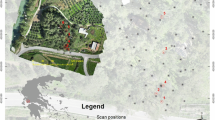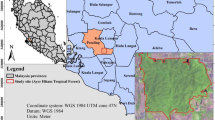Abstract
The application of terrestrial laser scanning (TLS) in capturing forest inventory parameters such as diameter at breast height, height and diameters along stem profiles, and in monitoring forest growth, was investigated and validated by comparison with conventionally measured individual tree parameters and plot-level forest growth in a stand of Sitka spruce (Picea sitchensis (Bong.) Carr.) in Ireland. The data acquisition for all the plots with different tree sizes and different slopes was carried out using a terrestrial laser scanner (FARO LS 800 HE80) in November 2007 and November 2009, using the same plot centres and measurement procedures. The point cloud data were processed with Autostem™ software. The results showed that TLS enables the acquisition of forest stand parameters with an acceptable accuracy. Pruning of the lower branches did not improve tree recognition and the number of (partly) occluded trees stayed the same. Over the 2-year period, the average difference between the volume increment of the trees visible to the scanner derived using the conventional method and Autostem™ was 4.77 m3 ha−1 and resulted in scanner-derived estimates that were lower than the estimates obtained by conventional method by 6.1 %. Using a simple correction factor to account for occlusion in the laser scanner data, the difference between these estimates for all trees in the stand became an over-estimation by 6.96 m3 ha−1 (8.1 %). At heights up along the stems >15 m, the errors in stem diameter estimates started to escalate.




Similar content being viewed by others
References
Aschoff T, Spiecker H (2004) Algorithms for the automatic detection of trees in laser scanner data. International Archives of Photogrammetry, Remote Sensing and Spatial Information Sciences pp 71–75
Bienert A, Maas HG, Scheller S (2006) Analysis of the information content of terrestrial laserscanner point clouds for the automatic determination of forest inventory parameters. Workshop on 3D Remote Sensing in Forestry pp 1–6
Bienert A, Scheller S, Keane E, Mohan F, Nugent C (2007) Tree detection and diameter estimations by analysis of forest terrestrial laserscanner point clouds. ISPRS workshop on Laser Scanning 2007 and SilviLaser 2007, Espoo, Finland pp 50–55
Bruce D (1975) Evaluating accuracy of tree measurements made with optical instruments. For Sci 21(4):421–426
Danson FM, Hetherington D, Morsdorf F, Koetz B, Allgower B (2007) Forest canopy gap fraction from terrestrial laser scanning. Geosci Remote Sens Lett IEEE 4(1):157–160
Henning JG, Radtke PJ (2006) Detailed stem measurements of standing trees from ground-based scanning lidar. For Sci 52:67–80
Hopkinson C, Chasmer L, Young-Pow C, Treitz P (2004) Assessing forest metrics with a ground-based scanning lidar. Can J For Res 34(3):573–583
Hradetzky J (1999) The assessment of tree heights in forest inventories for Baden-Württemberg. Austrian J For Sci 116:119–128
Hyyppä J, Hyyppä H, Leckie D, Gougeon F, Yu X, Maltamo M (2008) Review of methods of small-footprint airborne laser scanning for extracting forest inventory data in boreal forests. Int J Remote Sens 29:1339–1366
Jupp D, Culvenor D, Lovell J, Newnham G (2005) Evaluation and validation of canopy laser radar (LIDAR) systems for native and plantation forest inventory. Canberra, ACT, Australia
Lovell JL, Jupp DLB, Culvenor DS, Coops NC (2003) Using airborne and ground-based ranging lidar to measure canopy structure in Australian forests. Can J Remote Sens 29(5):607–622
Lovell JL, Jupp DLB, Newnham GJ, Culvenor DS (2011) Measuring tree stem diameters using intensity profiles from ground-based scanning lidar from a fixed viewpoint. Isprs J Photogramm Remote Sens 66:46–55
Maas H-G, Bienert A, Scheller S, Keane E (2008) Automatic forest inventory parameter determination from terrestrial laser scanner data. Int J Remote Sens 29(5):1579–1593
Matthews RW, Mackie ED (2006) Forest mensuration: a handbook for practitioners. Forestry Commission, Edinburgh
McInerney DO, Suarez-Minguez J, Valbuena R, Nieuwenhuis M (2010) Forest canopy height retrieval using LiDAR data, medium-resolution satellite imagery and kNN estimation in Aberfoyle, Scotland. Forestry 83:195–206
Murphy GE, Acuna MA, Dumbrell I (2010) Tree value and log product yield determination in radiata pine (Pinus radiata) plantations in Australia: comparisons of terrestrial laser scanning with a forest inventory system and manual measurements. Can J For Res 40:2223–2233
Nugent C, Bridge D, Murphy G, Øyen B-H (2009) Case-based support for forestry decisions: How to see the wood from the trees. In: McGinty L, Wilson D (eds) Case-based reasoning research and development. Lecture Notes in Computer Science 5650/2009. Springer, Berlin, pp 479–493
Parker GG, Harding DJ, Berger ML (2004) A portable LIDAR system for rapid determination of forest canopy structure. J Appl Ecol 41(4):755–767
Pfeifer N, Briese C (2007) Geometrical aspects of airborne and terrestrial laser scanning. International Archive of Photogrammetry, Remote Sensing and Spatial Information Sciences Espoo, Finland pp 311–319
Russo SE, Wiser SK, Coomes DA (2007) Growth—size scaling relationships of woody plant species differ from predictions of the metabolic ecology model. Ecol Lett 10(10):889–901
Sarkar D (2008) Lattice: multivariate data visualization with R. Springer, New York
SAS Institute Inc (2009) SAS/STAT® User’s Guide Version 9.2. SAS Institute Inc, Cary
Schumacher FX, Hall F (1933) Logarithmic expression of timber-tree volume. J Agric Res 47(9):719–734
Strahler A, Jupp D, Woodcock C, Schaaf C, Yao T, Zhao F, Yang X, Lovell J, Culvenor D, Newnham G, Ni-Miester W, Boykin-Morris W (2008) Retrieval of forest structural parameters using a ground-based lidar instrument (Echidna (R)). Can J Remote Sens 34:S426–S440
Tansey K, Selmes N, Anstee A, Tate NJ, Denniss A (2009) Estimating tree and stand variables in a Corsican Pine woodland from terrestrial laser scanner data. Int J Remote Sens 30(19):5195–5209
van Leeuwen M, Nieuwenhuis M (2010) Retrieval of forest structural parameters using LiDAR remote sensing. Eur J For Res 129:749–770
Watt PJ, Donoghue DNM (2005) Measuring forest structure with terrestrial laser scanning. Int J Remote Sens 26:1437–1446
Yao T, Yang XY, Zhao F, Wang ZS, Zhang QL, Jupp D, Lovell J, Culvenor D, Newnham G, Ni-Meister W, Schaaf C, Woodcock C, Wang JD, Li XW, Strahler A (2011) Measuring forest structure and biomass in New England forest stands using Echidna ground-based lidar. Remote Sens Environ 115(11):2965–2974
Acknowledgments
This research was funded by COFORD (The Council for Forest Research and Development), a division of the Department of Agriculture, Food and the Marine. The cooperation of Treemetrics Ltd. and Purser Tarleton Russell Ltd. (PTR) is gratefully acknowledged, as is the access given by Coillte to their forests. The authors are grateful to the reviewers for valuable comments.
Author information
Authors and Affiliations
Corresponding author
Additional information
Communicated by Gerald Kaendler.
Rights and permissions
About this article
Cite this article
Mengesha, T., Hawkins, M. & Nieuwenhuis, M. Validation of terrestrial laser scanning data using conventional forest inventory methods. Eur J Forest Res 134, 211–222 (2015). https://doi.org/10.1007/s10342-014-0844-0
Received:
Revised:
Accepted:
Published:
Issue Date:
DOI: https://doi.org/10.1007/s10342-014-0844-0




